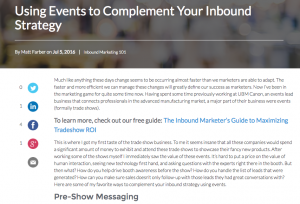IT and other business units are often oil and water. They might be combined together, but they don’t mix well and tend to keep to themselves. Companies that want to compete in the fast-paced digital world need to achieve IT – business alignment. What’s required for bridging this gap is a cultural shift, where other department heads do not view IT as a combative group that is separate from the overall business goals but rather a team that is integral to the success of achieving business goals through digital transformation. And on the IT side, it’s imperative they understand the needs and goals of other departments and don’t obstruct or slow needed projects.
A simple way to move this relationship forward is to encourage open communication. Companies need dialogue between the two groups so they can understand each other’s goals and the steps they need to take to move forward. IT has to set expectations and be able to discuss why an initiative might be technically challenging, but they also have to appreciate the need for quality customer-facing technologies. And the business units should be understanding of the technical requirements and know their “simple requests” might require a considerable back-end technical change.
Consider these various elements that need to effectively achieve IT – business alignment:
Focus on Building Experiences – Not the Technology
Businesses that operate in the omnichannel environment understand the need for a smooth, consistent, and engaging customer experience. We talk about it extensively at TechBlocks, and it’s a guiding principle that influences the solutions we recommend for our clients.
IT and other business units can be better aligned when they have common goals that expand across the business. Shaping and improving the customer experience should be one of these fundamental goals, one that guides all decisions within the company.
A sound starting block is for IT and other business units to take a baseline of their current processes, asking several questions:
- Can we move beyond the details and challenges of the actual tech and focus on actual real experiences?
- How do customers use our technology and how do we make that experience; easier, faster, engaging, and informative?
- For internal tech processes, how can the experience be improved? Is there room for automation or changes to the UI of certain solutions such as CRM? Discuss the relationship between more efficient internal-facing technology and more satisfied end customers.
- What are the current experience-related bottlenecks? If they aren’t known, how can we use data to find and then correct problems?
Gains in customer experience serve as win-win situations for both IT and other business units. With a unifying goal, they can both showcase achievements to upper management and relate how their departments are vital for improving the customer experience (and gains in revenue.)
Enable Agile Delivery
In some organizations, there are repeated mistakes when it comes to new technologies. Perhaps marketing and sales assumed, for example, a CRM solution offered certain functionalities, but never relayed that request to IT. Or IT promoted the use of a new internal application, but didn’t properly transfer data from a legacy system or they did not offer proper training to the user base. Setting expectations and goals is vital for delivering applications and systems quickly. And this speed is vital for the modern organization. Companies that cannot deliver the latest technology tools that help their customers or internal staff risk losing out market share to competitors.
Consider a business merger. The newly formed company has to integrate and consolidate various systems after the merger, an endeavor that takes time and costs money. Every stakeholder should be involved with the process from the start, with built-in time for unexpected delays. However, with IT and other departments involved from the outset, the time-to-completion can be greatly reduced.
Manage Regulation, Governance, and Security
To properly handle the complexities of data regulation, governance, and security, there is again the pressing need for an open dialog. All business units must respect the rules and limitations set by IT and legal when it comes to security and governance. Otherwise, the company is open to a compliance failure or a brand-destroying data breach.
- Security Protocols: IT and other business units need to balance the need for security and accessibility. For example, marketing departments might want partner organizations to have access to internal data, but IT naturally wants to place some restrictions. When the two sides have open lines of communication they can find middle ground. Perhaps, in this case, some of the more personal information is hidden from the information sharing.
- Regulation & Governance: IT should ask for support from the highest levels of management to reiterate the importance of bulletproof adherence to regulations and governance as they pertain to the storage and transmission of sensitive data. With governance, there’s often the stakeholders of IT, legal, and the actual users. IT has to manage an ever-growing amount of information, legal provides guidelines on risk mitigation and data storage standards, and the users want unfettered access to the information they need while understanding their role in data management.
Business & Finance Articles on Business 2 Community
(33)
Report Post




